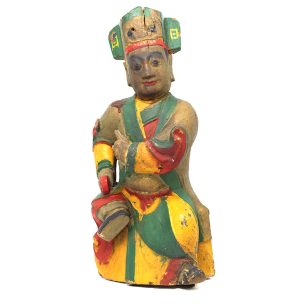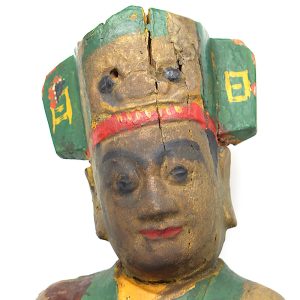-
Sale!


$2,950.00 Original price was: $2,950.00.$1,975.00Current price is: $1,975.00.
Overall Ht: 16” W: 28” D: 6” | CALL 213-568-3030 OR EMAIL [email protected] FOR SHIPPING COST
This rare 5 piece apple green Shiwan ceramic “garniture set” comprised of two vases, 2 candlestick holders and a large censer was originally placed on a family altar in a central room which was the focal point of an affluent Chinese dwelling. Ritually used to perform ancestral offerings on a daily, semimonthly, and seasonal basis, compete sets in excellent condition are relative rare.
-


$795.00
This fine antique Chinese wood carving was likely placed in a clan shrine or home altar with other religious images, ancestor figures or folk heroes reflecting the Chinese syncretic tradition that adhered to multiple spiritual and belief systems. Although it is difficult to identify specific figures, this image is likely a Taoist priest in officials…
-
Sale!


$1,250.00 Original price was: $1,250.00.$625.00Current price is: $625.00.
H: 15.25″ W: 6.75″ D: 6.75″ |CALL 213-568-3030 OR EMAIL [email protected] FOR SHIPPING
Zhenwu (Perfected Warrior) is one of the most important and powerful Taoist deities, god of one of the 4 cardinal directions (the north) revered for his potent magical powers to suppress demonic forces. This provincial image for personal devotion and reflects his classic iconography: seated on a throne, bare feet resting on a snake and a tortoise, a celestial scarf and maille armor. Intricately carved he has a powerful presence.
-


$395.00
This image from Guandong wears typical Taoist priest or shaman attire – an undergarment crossed at the neck, an overcoat clasped at the waist and a double-winged high hat centered with an image of a taotie. The taotie is a mystical animal sometimes on the hat of Taoist priests or shamans as a guardian or…
-


$375.00
H: 8.25″ W: 5.5″ D: 4″ | FREE SHIPPING WITHIN CONTINENTAL U.S.!
Guandi, the God of War and Justice and Protector of China and its citizens was a Chinese model of loyalty, virtue and morality and was depicted in Temples and home shrines throughout China. This antique figurine was probably part of a larger carving. He wears military maille, black gloves with a carved taotie which is a warning against gluttony and is covered in gold as a sign of power. The open back confirms it was consecrated by a Taoist priest. Mounted on a frosted acrylic stand.
End of content
End of content










